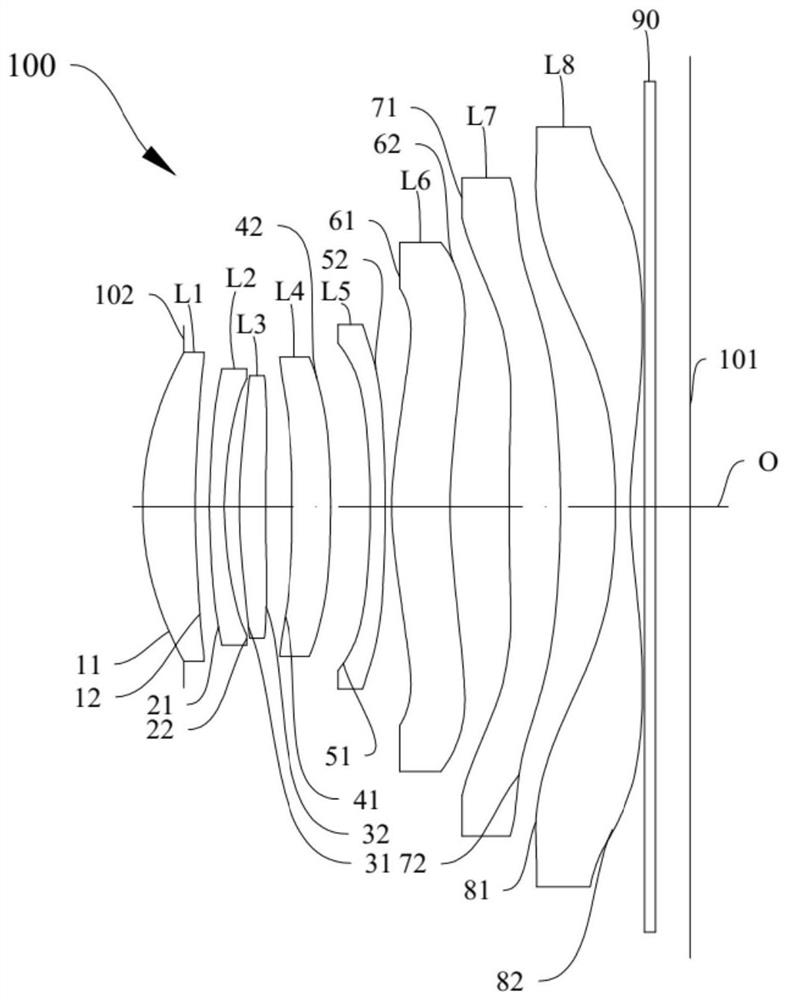Optical lens, camera module and electronic equipment
An optical lens and lens technology, applied in the direction of optics, optical components, instruments, etc., to achieve the effect of reducing high-order aberrations, balancing chromatic aberrations, and shortening the total length
- Summary
- Abstract
- Description
- Claims
- Application Information
AI Technical Summary
Problems solved by technology
Method used
Image
Examples
no. 1 example
[0098] The structural diagram of the optical lens 100 disclosed in the first embodiment of the present application is as follows figure 1 As shown, the optical lens 100 includes a diaphragm 102, a first lens L1, a second lens L2, a third lens L3, a fourth lens L4, a fifth lens L5, a first lens L1, a fourth lens L4, a fifth lens L5, and a first lens L1 arranged sequentially from the object side to the image side along the optical axis O. Six lenses L6, seventh lens L7, eighth lens L8 and infrared filter 90.
[0099] Further, the first lens L1 has a positive refractive power, the second lens L2 has a negative refractive power, the third lens L3 has a positive refractive power, the fourth lens L4 has a positive refractive power, the fifth lens L5 has a negative refractive power, and the sixth lens L3 has a positive refractive power. Lens L6 has positive refractive power, seventh lens L7 has negative refractive power, and eighth lens L8 has negative refractive power.
[0100] Fur...
no. 2 example
[0114] The structural diagram of the optical lens 100 disclosed in the second embodiment of the present application is as follows image 3 As shown, the optical lens 100 includes a diaphragm 102, a first lens L1, a second lens L2, a third lens L3, a fourth lens L4, a fifth lens L5, a first lens L1, a fourth lens L4, a fifth lens L5, and a first lens L1 arranged sequentially from the object side to the image side along the optical axis O. Six lenses L6, seventh lens L7, eighth lens L8 and infrared filter 90.
[0115] Further, the first lens L1 has a positive refractive power, the second lens L2 has a negative refractive power, the third lens L3 has a positive refractive power, the fourth lens L4 has a positive refractive power, the fifth lens L5 has a negative refractive power, and the sixth lens L3 has a positive refractive power. Lens L6 has positive refractive power, seventh lens L7 has positive refractive power, and eighth lens L8 has negative refractive power.
[0116] Fu...
no. 3 example
[0126] The structural diagram of the optical lens 100 disclosed in the third embodiment of the present application is as follows Figure 5 As shown, the optical lens 100 includes a diaphragm 102, a first lens L1, a second lens L2, a third lens L3, a fourth lens L4, a fifth lens L5, a first lens L1, a fourth lens L4, a fifth lens L5, and a first lens L1 arranged sequentially from the object side to the image side along the optical axis O. Six lenses L6, seventh lens L7, eighth lens L8 and infrared filter 90.
[0127] Further, the first lens L1 has a positive refractive power, the second lens L2 has a negative refractive power, the third lens L3 has a positive refractive power, the fourth lens L4 has a negative refractive power, the fifth lens L5 has a negative refractive power, and the sixth lens L3 has a negative refractive power. Lens L6 has positive refractive power, seventh lens L7 has positive refractive power, and eighth lens L8 has negative refractive power.
[0128] Fu...
PUM
 Login to View More
Login to View More Abstract
Description
Claims
Application Information
 Login to View More
Login to View More - R&D
- Intellectual Property
- Life Sciences
- Materials
- Tech Scout
- Unparalleled Data Quality
- Higher Quality Content
- 60% Fewer Hallucinations
Browse by: Latest US Patents, China's latest patents, Technical Efficacy Thesaurus, Application Domain, Technology Topic, Popular Technical Reports.
© 2025 PatSnap. All rights reserved.Legal|Privacy policy|Modern Slavery Act Transparency Statement|Sitemap|About US| Contact US: help@patsnap.com



